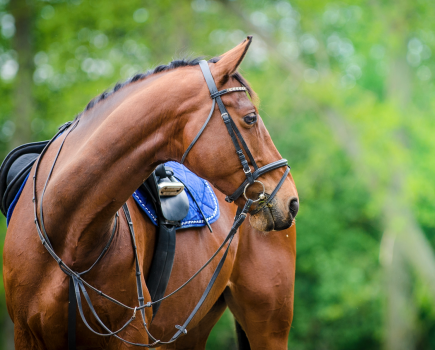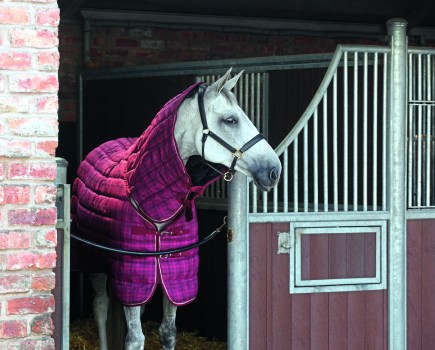Double bridles can seem complicated, so here we explain all that you need to know.
Double bridle design
The design of double bridles can vary and it’s important to recognise the different features and fixtures they can have.
Different designs can have a huge effect on the way each bridle works. Here are some key features explained:
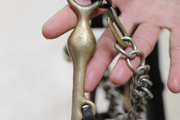 The Shank
The Shank
The shank of the curb can be fixed or sliding and of varying lengths.
A sliding shank allows the curb to move slightly as the bit is tipped when the rider takes up the contact. This is less precise than a fixed shank but a much milder action.
Shanks that are shorter in length also have a milder action.
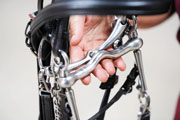 The curb and port
The curb and port
The action of the curb asks the horse to flex, while the thickness of the mouthpiece varies from bit to bit, as does the port in the centre.
A forward-slanting port can provide more room for the two bits to sit together nicely in the mouth, be comfier on the tounge (especially in a more fleshy mouth) and shouldn’t touch the roof of the mouth.
Ultimately the type of curb you need depends entirely on the make-up of your horse. Generally, the thicker the curb mouthpiece the milder the bit, and a high port makes the bit more devere, but it really depends on your horse.
A smaller mouth may require a thinner curb and smaller port, while a larger mouth may benefit from a thicker mouthpiece and a wider port.
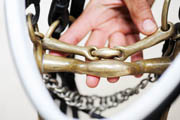 The snaffle or bridoon
The snaffle or bridoon
The bridoon is a smaller version of a snaffle bit and its action asks the horse to lift his head.
Commonly a single-jointed, loose-ring snaffle is used, but an eggbutt version can also be used.
A double-jointed bit with a lozenge will sit neatly in the port of the curb for a more comfortable fit
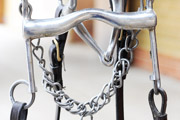 Curb Chain
Curb Chain
The curb chain should lie flat in the chin groove and a padded chain cover can be used for extra comfort.
Curb chains can have forward- or backward-facing hooks, but Claire advises that forward-facing hooks are a better choice, as backward-facing hooks can become caught in the horse’s lip when putting the bridle on.
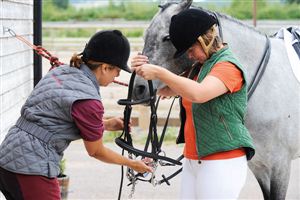
Fitting a double bridle for the first time should be done with care.
Tips for fitting a double bridle
1. Start by holding the bridle up against the side of your horse’s head to see whether it’s roughly the right size.
2. It’s important to treat the double bridle as a single bridle, and the two bits as one, as you put it on.
Put the reins over your horse’s neck and undo the curb chain.
Hold the two bits in your hand, as you normally would, ensuring that the snaffle sits behind the curb.
If you don’t do this, the snaffle can sit in the wrong place or twist.
3. It’s also essential that the curb chain is secured at the right length as it controls the severity of the curb bit. If it’s too loose and would allow the curb to rotate too far in the horse’s mouth, causing a lot of pressure on the tongue as the bit rotates forwards.
4. The curb chain should be fitted so that it acts when the lower cheek of the curb rotates to 45 degrees.
If the curb chain is too short, the action of the curb bit is very severe and puts great pressure on the poll and the lower jar – a rough rider may even break the jaw bone.
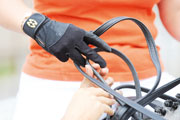
A double bridle will only work if used correctly
How to hold the reins of a double bridle
A double bridle will only work if used correctly.
Holding the reins incorrectly will mean you’re likely to cause your horse to overbend, or you’ll feel some strong resistance to the contact.
To use a double bridle most effectively, you must hold the snaffle rein as you would normally between your third and little finger.
The curb rein should sit between your second and third finger, while your thumbs should sit on top of both reins, keeping them secure.
To begin with, ride your horse on a 20m circle in walk, but ensure that the curb rein is slack so that you can first get used to the feeling of holding two reins.
When you do take up the curb rein and walk on the circle, your seat bones should follow the movement, as normal.
You don’t follow the movement of your horse with your hands, you follow it with your hips.
When you’re ready to shorten the curb rein remember that your seat and legs will continue to work your horse into an outline, your hands are to feel with the rein, not fiddle.
Remind yourself that the double bridle is only for fine tuning, it’s a very subtle action.
REMEMBER:
- Hold the snaffle rein between your third and little finger
- Hold the curb rein between your second and third finger
- Keep your thumbs on top
Top Tip – before you ride in a double bridle for the first time, it’s a good idea to have a play with the action of the two bits from the ground – this gives you the opportunity to check that the horse is OK with this feeling.





